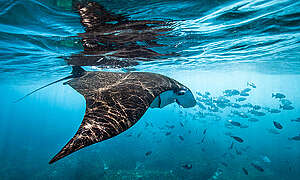This UN treaty could be a game-changer for ocean protection. Here’s how it works, and how together we’ll make sure world leaders get it right.
From climate change and plastic pollution, to mining and overfishing, the threats facing our oceans are getting more urgent every day.
Now though, there’s a ray of hope. Scientists have drawn up a bold rescue plan for our oceans – and it’s brilliantly simple: we cover the planet in ocean sanctuaries, putting a third of the seas off-limits to fishing, mining, drilling and other destructive industries.
If the plan goes ahead, it’ll be one of the biggest conservation efforts in human history, creating millions of square kilometres of new protected areas.
Clearing the way for ocean sanctuaries
But here’s the problem: at the moment, there’s no way to create new sanctuaries outside countries’ national waters. We can’t protect these huge areas of the ocean without an international agreement on how this protection would work.
Governments have started work on a Global Ocean Treaty at the UN, and if they get it right it’ll give us the legal tools we need to start creating these new ocean sanctuaries. In a turbulent political climate, it would be a momentous demonstration of how international cooperation to protect our shared home can and should work.
So this year, we’re going all-out to make sure that happens. Through the new Protect the Oceans campaign, people all over the world will be pushing for a strong Global Ocean Treaty.
Countries have been discussing a treaty like this for years (and behind-the-scenes campaigning on this has been going on for a decade) but the real talks are just getting going. After a fortnight of meetings this month in New York, governments will come together for two more rounds of negotiations – one in August, and one next year, where a Global Ocean Treaty could be declared. Here’s a more detailed overview of what Greenpeace is calling for in the negotiations.
Who’s backing a strong treaty?
Many countries from around the world have already stated their support for a strong Global Ocean Treaty. These political leaders are listening to their people and to scientists, and are choosing to do what is best for them and for the planet.
Many countries from Africa, the Pacific and Caribbean islands, Latin America and Europe agree that the Global Ocean Treaty should explicitly allow for the creation of protected areas internationally, to replace the failing system of regional agreements and treaties we have now.
It’s our job to support and encourage these forward-thinking governments, making sure they know there’s a global movement backing them and giving them space to go even further.
And who’s holding things up?
Some governments, like US, Australia and Canada still lack vision and ambition, while Norway, Iceland, and Russia largely fall behind. We’ll be doing everything we can to make these countries step up in their ambition, and make sure their people and scientists are heard.
Sticking to the status quo won’t bring life back to the ocean – we’ve seen over and over again that the current patchwork system we have can’t protect marine life from the multiple pressures they face today. Our oceans are in crisis and simply can’t wait while countries drag their feet.
At this stage the negotiations could go either way, and the big fishing and mining companies are already working hard to keep the broken system that’s putting our blue planet in danger. So now it’s up to us to make sure governments do the right thing.
When we work together we can change the world. From stopping Shell’s oil drilling in the Arctic, to getting the world’s largest tuna company to clean up its act to protect people and the planet, we know how to stand up for our seas – and win.
Now it’s time to go even bigger. Over the next year, this mission will need all the courage, cunning and creativity we can find. But today, we need your help to get us there.


